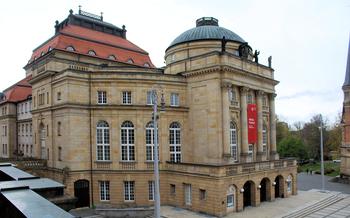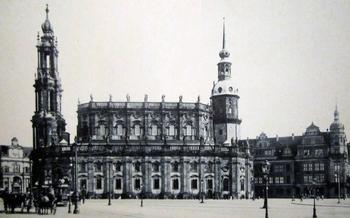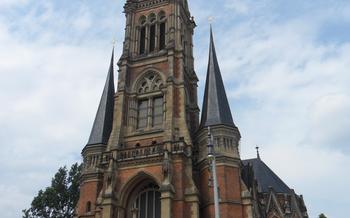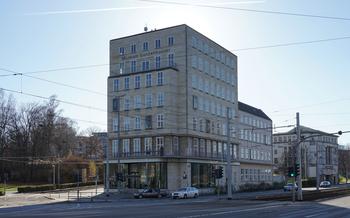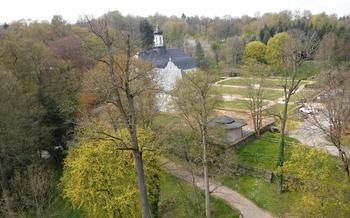
Red Tower
- The Red Tower: A Historical Landmark in Chemnitz
- Visiting the Red Tower: Practical Information
- Exploring the Tower's Interior
- The Red Tower as a Symbol of Chemnitz
- Historical Significance of the Red Tower
- Architectural Features of the Red Tower
- Legends and Myths Surrounding the Red Tower
- The Red Tower as a Cultural Venue
- The Red Tower in Literature and Art
- The Red Tower's Role in Tourism
- Renovation and Restoration Efforts
- The Red Tower's Surroundings
- Accessibility for Visitors
- Photography Opportunities
- Insider Tip: Hidden Gems of the Red Tower
The Red Tower: A Historical Landmark in Chemnitz
Rising proudly above the city of Chemnitz, the Red Tower stands as a testament to the city's rich history and architectural heritage. Constructed in the 12th century, this striking octagonal tower is one of the oldest surviving structures in Chemnitz and has witnessed centuries of transformation and upheaval. Its distinctive red brick and sandstone exterior, adorned with intricate Gothic details, has become an iconic symbol of the city.
The Red Tower's historical significance is deeply intertwined with the development of Chemnitz. Originally conceived as part of the city's medieval fortifications, the tower served as a watchtower, providing a strategic vantage point over the surrounding countryside. As Chemnitz grew and expanded, the tower's function evolved, transforming into a prison and later serving as a treasury. Throughout its existence, the Red Tower has stood resilient, withstanding wars, fires, and other calamities that have shaped Chemnitz's history.
Adding to the tower's allure is the captivating legend associated with its construction. According to local folklore, the tower was built by a master builder named Kunz von Kaufungen, who made a pact with the devil to complete the tower in record time. However, the devil demanded a price: the soul of the first person to enter the tower. In a twist of fate, Kunz tricked the devil by sending a rooster into the tower, saving his own soul and leaving the devil empty-handed.
This intriguing legend has captured the imagination of generations, adding to the mystique and charm of the Red Tower. Today, the tower stands as a proud symbol of Chemnitz's enduring spirit, a testament to the city's ability to overcome adversity and emerge stronger.
Visiting the Red Tower: Practical Information
The Red Tower is conveniently located in the heart of Chemnitz, within easy reach of other historical landmarks and attractions. To get there, visitors can take public transportation, such as buses or trams, to the Theaterplatz stop. From there, it is just a short walk to the tower. For those arriving by car, there are several parking garages nearby where you can leave your vehicle.
The Red Tower is open to the public from Tuesday to Sunday, with varying hours depending on the time of year. During the summer months, the tower is open from 10 am to 6 pm, while in the winter months, it closes an hour earlier at 5 pm. Admission fees are reasonable, with reduced rates for students, seniors, and families. Guided tours are available in both German and English, and visitors can book them in advance to ensure a spot.
The Red Tower is wheelchair accessible, with ramps and elevators providing easy access to all levels of the tower. Accessible restrooms are also available on-site. Visitors with disabilities can request assistance from the friendly staff, who are always ready to help.
Exploring the Tower's Interior
Ascending the spiral staircase within the Red Tower is akin to embarking on a journey through time. Each step reveals a new layer of the tower's rich history, culminating in the breathtaking panoramic views from the observation deck. Take your time as you make your way up, admiring the intricate stonework and the play of light through the narrow windows.
Once you reach the top, you'll be rewarded with an unparalleled vista of Chemnitz and its surroundings. The city's landmarks, including the Chemnitz Town Hall and the Theaterplatz, are spread out before you, while the distant hills and forests provide a picturesque backdrop.
In addition to the stunning views, the observation deck also houses a number of exhibitions and displays that delve into the tower's history and architecture. Learn about the tower's role in Chemnitz's medieval fortifications, its use as a watchtower and a prison, and its miraculous survival despite wars, fires, and other calamities.
The Red Tower as a Symbol of Chemnitz
The Red Tower has become an enduring symbol of Chemnitz, representing its rich history and resilience. Its distinctive silhouette has been featured in countless works of art, literature, and popular culture, solidifying its place as an icon of the city. In paintings and drawings, artists have captured the tower's imposing presence and intricate details, showcasing its architectural significance. Poets and writers have immortalized the tower in their verses, weaving tales of its historical significance and legendary associations.
The Red Tower's resilience has made it a symbol of Chemnitz's ability to overcome adversity. Despite wars, fires, and other calamities, the tower has stood steadfast, a testament to the city's enduring spirit. This resilience has resonated with the people of Chemnitz, who see the tower as a symbol of their own strength and determination. The tower's inclusion in Chemnitz's coat of arms further cements its status as a symbol of the city's identity and pride.
Historical Significance of the Red Tower
The Red Tower played a crucial role in Chemnitz's medieval fortifications, serving as a strategic watchtower. Its elevated position allowed guards to keep a vigilant eye on the city's surroundings, spotting approaching enemies or potential threats. The tower's thick walls and sturdy construction provided a reliable defense against attacks, making it an integral part of the city's protective measures.
Throughout history, the Red Tower has served various purposes beyond its military function. It was used as a prison, housing inmates in its dark and cramped cells. The tower's thick walls and isolated location made it a suitable place for confinement, ensuring that prisoners could not easily escape. The tower's role as a prison persisted for centuries, leaving a lasting mark on its history.
Despite wars, fires, and other calamities that have ravaged Chemnitz over the centuries, the Red Tower has remarkably survived, standing as a testament to its resilience. While other structures succumbed to destruction, the tower remained steadfast, its sturdy construction and historical significance ensuring its preservation. Today, the Red Tower stands as a symbol of Chemnitz's enduring spirit, its ability to rise from adversity, and its commitment to preserving its rich heritage.
Architectural Features of the Red Tower
The Red Tower is a remarkable example of medieval architecture, showcasing a unique blend of red bricks and sandstone. Its striking octagonal shape and intricate Gothic details set it apart from other towers in the region. The tower's height, standing at around 37 meters, makes it a dominant feature of the Chemnitz skyline, visible from various points across the city.
The tower's construction involved careful craftsmanship and attention to detail. The red bricks, which were predominantly used in the tower's construction, create a warm and inviting appearance, while the sandstone accents add a touch of elegance and sophistication. The octagonal shape of the tower is a distinctive feature, giving it a unique and eye-catching appearance.
The Gothic details, such as the pointed arches and intricate carvings, are particularly noteworthy. These elements add a sense of grandeur and artistry to the tower's overall design. The tower's exterior is adorned with decorative elements, including gargoyles and pinnacles, which further enhance its visual appeal.
Overall, the Red Tower's architectural features make it a masterpiece of medieval construction, blending functionality with aesthetic beauty. It serves as a testament to the skill and creativity of the builders who erected this iconic landmark.
Legends and Myths Surrounding the Red Tower
The Red Tower has inspired numerous legends and myths throughout its existence, capturing the imagination of locals and visitors alike. One of the most well-known tales is the legend of Kunz von Kaufungen, a renowned architect who is said to have built the tower. According to the legend, von Kaufungen made a pact with the devil to obtain the knowledge and skills necessary to construct such an impressive structure. In return, the devil demanded von Kaufungen's soul. However, the architect outsmarted the devil by building a hidden room within the tower, where he could hide until the devil's claim expired. To this day, some believe that von Kaufungen's spirit still haunts the tower, searching for his lost soul.
Another popular legend revolves around the tower's bell, which is said to possess supernatural powers. According to the story, the bell was cast using a secret alloy that gives it the ability to control the weather. When the bell is rung, it is said to have the power to summon storms, clear the skies, or even cause earthquakes. The bell's powers are said to be so potent that it is only rung on rare occasions, such as during times of great need or celebration.
Finally, there is the myth of the tower's secret underground passages. According to local folklore, the Red Tower is connected to a network of subterranean tunnels that stretch beneath the city of Chemnitz. These tunnels are said to have been used by the tower's guards to escape in times of danger or to transport prisoners to and from the tower's dungeon. Some believe that the tunnels may still exist today, hidden beneath the city's streets, waiting to be discovered.
The Red Tower as a Cultural Venue
In recent years, the Red Tower has undergone a remarkable transformation, evolving into a vibrant cultural hub in the heart of Chemnitz. The tower's unique and atmospheric interiors have become a sought-after venue for a diverse range of cultural events, including art exhibitions, concerts, and performances.
Local artists and performers are drawn to the Red Tower for its intimate and inspiring setting. The tower's exhibitions showcase a variety of artistic styles and mediums, from traditional paintings and sculptures to contemporary installations and experimental works. The tower's acoustics are well-suited for musical performances, creating an immersive and intimate atmosphere for concerts, recitals, and chamber music performances.
The Red Tower's transformation into a cultural venue has not only revitalized the tower itself but has also contributed to the city's cultural landscape. The tower's programming attracts a diverse audience, fostering a sense of community and encouraging dialogue and exchange. By providing a platform for local artists and performers, the Red Tower plays a crucial role in promoting Chemnitz's cultural identity and fostering a vibrant and thriving arts scene.
The Red Tower in Literature and Art
The Red Tower has served as an inspiring muse for artists, writers, and poets throughout history. Its unique appearance and rich history have made it a popular subject in various forms of art. Paintings, drawings, and sculptures often depict the tower's distinctive silhouette against the Chemnitz skyline. In literature, the tower has been featured in novels, poems, and plays, where it serves as a powerful symbol of the city's past and present. The tower's presence in literature and art adds to its cultural significance, making it an integral part of Chemnitz's identity. By exploring the various artistic representations of the tower, visitors can gain a deeper appreciation for its historical and cultural value.
The Red Tower's Role in Tourism
The Red Tower stands as a prominent landmark in Chemnitz, attracting a multitude of tourists each year. Its captivating history, architectural beauty, and panoramic views make it a must-visit destination for travelers seeking cultural and historical experiences. The tower is incorporated into guided city tours and heritage walks, providing visitors with an in-depth exploration of Chemnitz's rich past. As a symbol of the city's resilience and transformation, the Red Tower plays a crucial role in promoting Chemnitz as a vibrant and culturally significant destination. Its unique charm and historical significance contribute to the city's tourism industry, enticing visitors from around the world to discover the many wonders that Chemnitz has to offer.
Renovation and Restoration Efforts
Throughout its history, the Red Tower has undergone several renovations and restorations to preserve its historical integrity and ensure its continued existence as a beloved landmark. The first major renovation took place in the 19th century, when the tower's exterior was restored to its original red brick appearance. In the early 20th century, the tower's interior was renovated to create exhibition spaces and a viewing platform.
One of the most significant restoration projects was undertaken in the 1970s, when the tower was in danger of collapse due to structural damage. This project involved reinforcing the tower's foundations, repairing the brickwork, and replacing the aging wooden staircase with a new metal one. The tower was also equipped with modern safety features, such as fire escapes and lighting.
In recent years, the Red Tower has undergone further renovations to improve accessibility for visitors with disabilities. Ramps, elevators, and accessible restrooms have been installed, making it possible for everyone to enjoy the tower's history and stunning views.
As a protected historical monument, the Red Tower is subject to strict preservation guidelines. Any renovation or restoration work must be carried out in a way that respects the tower's original design and materials. This ensures that the tower remains a faithful representation of its rich history and continues to serve as a symbol of Chemnitz's resilience and transformation.
The Red Tower's Surroundings
The Red Tower is situated in the heart of Chemnitz's historic city center, making it an integral part of the city's rich cultural landscape. The tower's immediate surroundings boast a wealth of attractions that invite visitors to delve deeper into Chemnitz's history and heritage.
A short stroll from the Red Tower stands the Chemnitz Town Hall, an architectural masterpiece that showcases the city's opulence and grandeur. This stunning 19th-century building houses the city's administrative offices and is open to visitors for guided tours.
Adjacent to the town hall is the Theaterplatz, a vibrant square that serves as a cultural hub for Chemnitz. This lively plaza is home to the Chemnitz Opera House, renowned for its world-class performances and stunning architecture. The Theaterplatz also hosts various events, concerts, and festivals throughout the year, creating a vibrant atmosphere that draws locals and tourists alike.
The Red Tower's surroundings are a testament to Chemnitz's rich history and cultural heritage. Visitors can easily spend hours exploring the nearby attractions, immersing themselves in the city's stories, and discovering hidden gems around every corner.
Accessibility for Visitors
The Red Tower is committed to providing an inclusive and welcoming experience for all visitors, regardless of their abilities. To ensure this, the tower has implemented various accessibility features to accommodate visitors with disabilities.
The tower's entrance is equipped with a ramp, making it easily accessible for wheelchair users and visitors with limited mobility. Inside the tower, an elevator provides convenient access to the different levels, eliminating the need to climb stairs.
Accessible restrooms are available within the tower, ensuring that visitors with special needs can comfortably use the facilities. Additionally, the tower's staff is trained to assist visitors with disabilities, providing guidance and support throughout their visit.
Guided tours tailored specifically for visitors with disabilities are also available upon request. These tours offer a comprehensive overview of the tower's history, architecture, and significance, while accommodating the needs of visitors with hearing impairments, visual impairments, or other disabilities.
With its accessible features and dedicated staff, the Red Tower ensures that all visitors have the opportunity to explore and appreciate its rich history and stunning views.
Photography Opportunities
The Red Tower presents a wealth of opportunities for photography enthusiasts. Its striking red brick exterior, intricate Gothic details, and octagonal shape make it a visually captivating subject. Whether you're a professional photographer or simply enjoy capturing beautiful images, the Red Tower is sure to inspire your creativity.
Tips for Stunning Photos:
-
Use the right lens: A wide-angle lens is ideal for capturing the tower's full height and grandeur. For close-up shots of architectural details, consider using a macro lens.
-
Experiment with different angles: Walk around the tower and experiment with different angles to find the most flattering perspective. Try shooting from below to emphasize the tower's height or from a higher vantage point to capture the surrounding cityscape.
-
Pay attention to lighting: The best time to photograph the Red Tower is during the golden hours of sunrise and sunset when the warm light casts a beautiful glow on the brickwork.
-
Incorporate the surroundings: The Red Tower is situated in a charming historic square. Take advantage of this by incorporating surrounding buildings, trees, or people into your composition for a more dynamic shot.
-
Don't be afraid to get creative: The Red Tower is a versatile subject that lends itself to various creative interpretations. Experiment with different shutter speeds, apertures, and filters to create unique and artistic images.
Insider Tip: Hidden Gems of the Red Tower
Beyond its iconic exterior and panoramic views, the Red Tower holds several hidden gems waiting to be discovered by curious visitors. As you explore the tower's medieval architecture, keep an eye out for intricate carvings and inscriptions that adorn its walls, each telling a unique tale of the tower's rich history.
Descent into the tower's underground chambers, accessible through a discreet doorway, to uncover a network of secret passages that once served as escape routes during times of siege. Imagine the footsteps of medieval soldiers echoing through these hidden tunnels as they prepared to defend their city.
Seek out the tower's oldest bell, rumored to possess supernatural powers. Listen closely, and you might hear its faint toll, a haunting reminder of the tower's many centuries of existence.

